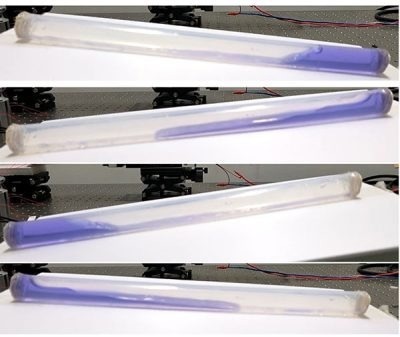Advancements in "blue energy" harvesting brings researchers closer to harnessing the relentless ebb and flow of the ocean.
 Researchers harvest more energy from waves by moving a liquid-solid nanogenerator’s electrode to the end of the tube where the water crashes. Image Credit: Adapted from ACS Energy Letters 2024
Researchers harvest more energy from waves by moving a liquid-solid nanogenerator’s electrode to the end of the tube where the water crashes. Image Credit: Adapted from ACS Energy Letters 2024
Researchers have found that by relocating the electrode from the center of a liquid-filled tube that sways back and forth to the end where the water crashes with the greatest force, there is a significant increase in the amount of wave energy that can be captured. The study was published in ACS Energy Letters.
The wave-energy harvesting device refined by the researchers is known as a liquid-solid triboelectric nanogenerator (TENG). Water sloshes back and forth against the tube's inside, converting mechanical energy into electrical energy through the TENG.
The limited energy production of these gadgets is one reason they are not yet suitable for widespread use. The goal of Guozhang Dai, Kai Yin, Junliang Yan, and associates was to maximize the energy-harvesting capacity of a liquid-solid TENG by strategically placing the energy-collecting electrode.
Two TENGs were constructed by the researchers using 16-inch clear plastic tubes. A copper foil electrode was positioned inside the first device in the center of the tube, as is customary in liquid-solid TENGs.
They placed an electrode of copper foil at one end of the tube for the new design. After adding water to the tubes to a fourth of the way, the researchers sealed the ends. The electrodes were wired into an external circuit.
By positioning both devices on a benchtop rocker, water oscillated within the tubes, generating electrical currents by converting mechanical energy. This process involved friction from the water impacting or sliding against the electrodes, transforming it into electricity. The researchers discovered that the optimized design boosted the device's mechanical energy to electrical current conversion by 2.4 times compared to the standard design.
In a different experiment, water entered the electrode-covered section of the tube and subsequently flowed away, causing the optimized TENG to blink 35 LEDs on and off. According to the researchers, these experiments set the stage for more extensive blue-energy harvesting from ocean waves and highlight the potential uses for their device in other fields, including wireless underwater signaling communications.
The study was funded by the National Natural Science Foundation of China and the National Key Research and Development Program of China. The authors acknowledge the computing resources provided by the High Performance Computing Center of Central South University.
Journal Reference:
Zhang, H., et al. (2024) Space Volume Effect in Tube Liquid–Solid Triboelectric Nanogenerator for Output Performance Enhancement. ACS Energy Letters. doi.org/10.1021/acsenergylett.4c00072